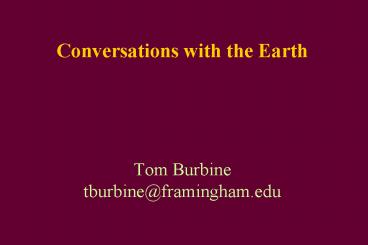Conversations with the Earth Tom Burbine tburbine@framingham.edu - PowerPoint PPT Presentation
Title:
Conversations with the Earth Tom Burbine tburbine@framingham.edu
Description:
Conversations with the Earth Tom Burbine tburbine_at_framingham.edu * * * * * * * * Coronal Mass Ejections are large clouds of magnetized gas ejected into space by the ... – PowerPoint PPT presentation
Number of Views:104
Avg rating:3.0/5.0
Title: Conversations with the Earth Tom Burbine tburbine@framingham.edu
1
Conversations with the EarthTom
Burbinetburbine_at_framingham.edu
2
Figure 15.4
3
Density
Temperature
4
Parts of SunCore
- Core 15 million Kelvin where fusion occurs
5
Figure 15.4
6
Radiation zone
- Radiation zone region where energy is
transported primarily by radiative diffusion - Radiative diffusion is the slow, outward
migration of photons
7
Figure 15.13
8
Photons emitted from Fusion reactions
- Photons are originally gamma rays
- Tend to lose energy as they bounce around
- Photons emitted by surface tend to be visible
photons - Takes about a million years for the energy
produced by fusion to reach the surface
9
Figure 15.4
10
Convection Zone
- Temperature is about 2 million Kelvin
- Photons tend to be absorbed by the solar plasma
- Plasma is a gas of ions and electrons
- Hotter plasma tends to rise
- Cooler plasma tends to sink
11
Figure 15.14
12
Granulation bubbling pattern due to
convection bright hot gas, dark cool gas
Figure 15.14
13
(No Transcript)
14
Figure 15.10
15
Figure 15.4
16
Photosphere
- Photosphere is the solar surface
- Where photons escape into space
17
Sunspots
- Sunspots are on the photosphere
- Have temperatures of 4,000 K
- Photosphere is 5,800 K
18
(No Transcript)
19
(No Transcript)
20
Sunspots
- Sunspots are regions of intense magnetic activity
- Charged particles tend to follow magnetic field
lines - A magnetic field exerts a magnetic force on
moving electric charges
21
(No Transcript)
22
(No Transcript)
23
(No Transcript)
24
Sunspot Cycle
Figure 15.21
The cycle has a period of approximately 11 years,
but the interval between maxima can be as short
as 7 years and as long as 15 years.
25
Maunder Minimum
- Between 1645 and 1715, the sunspot activity
virtually stopped - Identified by E. W. Maunder from historical
sunspot records
http//science.nasa.gov/headlines/y2003/17jan_solc
on.htm
26
- Since sunspots are darker than the surrounding
photosphere it might be expected that more
sunspots would lead to less solar radiation. - However, the surrounding margins of sunspots are
hotter than the average, and so are brighter - More sunspots increase the sun's brightness.
http//upload.wikimedia.org/wikipedia/commons/0/0d
/Solar-cycle-data.png
27
Figure 15.4
28
Atmosphere of the Sun
- Chromosphere above the photosphere and below
the corona - Temperature is about 10,000 Kelvin
- Most of the Suns ultraviolet light is emitted
from this region
29
See Corona during eclipse
30
Atmosphere of the Sun
- Corona tenuous uppermost layer of the Suns
atmosphere - Temperature is about 1 million Kelvin
- Most of the Suns X-rays are emitted from this
region
31
Corona
- Extends millions of kilometers into space
- Sun's corona is constantly being lost as solar
wind.
32
Solar Wind
- Stream of charged particles continually blown
outward from the Sun
33
STEREO
- STEREO (Solar TErrestrial RElations Observatory)
is a solar observation mission which was launched
in October 2006. - Two identical spacecraft were launched into
orbits that cause them to (respectively) pull
further ahead of and fall gradually behind the
Earth. - The spacecraft will do stereoscopic imaging of
the Sun and processes such as Coronal Mass
Ejections.
34
- Coronal Mass Ejections are large clouds of
magnetized gas ejected into space by the sun
35
http//en.wikipedia.org/wiki/STEREO
36
- http//www.nasa.gov/mission_pages/stereo/main/inde
x.html
37
- http//www.hulu.com/watch/63320/cosmos-the-lives-o
f-the-starss-p1-so-i0
38
Any Questions?































